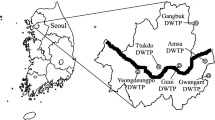Abstract
Because of increasing need to balance health risks for pathogen control and disinfection by-products (DBP) formation in drinking water supplies, water utilities are forced to closely examine and optimize their disinfection practices. This research was designed to investigate the effects of independent variables of dissolved organic carbon (DOC), ferric chloride dosage, chlorine dose, and reaction time on trihalomethanes (THMs) formation in Terkos Lake Water (TLW) of Istanbul City. A statistically-based empirical model was developed for predicting THM formation during enhanced coagulation. The R 2 and F value of model were 0.762 and 460, respectively. The model was found to be statistically significant for all four variables, and model predictions appear to be most accurate for this study. A multiple linear model exhibited the best fit of data. It was observed that THM formation depended primarily on DOC removal. Model calibration, testing and validation were accomplished by using independent data set.
Similar content being viewed by others
References
Abdullah, M. A., Yew, C. H. and Ramli, M. S.: 2003 ‘Formation, modeling and validation of trihalomethanes (THM) in Malaysian drinking water: A case study in the districts of Tampin, Negeri Sembilan and Sabak Bernam, Selangor, Malaysia’, Water Research 37, 4637–4644.
Adin, A., Katzhendler, J., Alkaslassy, D. and Rav, A. C.: 1991, ‘Trihalomethanes formation in chlorinated drinking water: A kinetic model’, Water Research 25, 797–805.
APHA: 1998, Standard Methods for the Examination of Water and Wastewater, 20th edition, American Public Health Association, Washington, DC.
Babcock, D. and Singer, P. C.: 1979, ‘Chlorination and coagulation of humic and fulvic acids’, J. AWWA 71, 149–152.
Bellar, T. A., Lichtenberg, J. J. and Kroner, R. C.: 1974 ‘The occurrence of organohalogens in chlorinated drinking waters’, J. AWWA 66 (11), 703–706.
Crozes, G., White, P. and Marshall, M.: 1995, ‘Enhanced coagulation: Its effect on NOM removal and chemical costs’, J. AWWA 87 (2), 78–89.
Draper, N. R. and Smith, H.: 1981, Applied Regression Analysis, John Wiley, New York, NY.
Edzwald, J. K., Becker, W. C. and Tambini, S. J.: 1985, ‘Surrogate parameters for monitoring organic matter and THM precursors’, J. AWWA 77, 122–131.
Kavanaugh, M. C., Trussell, A. R., Cromer, J. and Trussell, R. R.: 1980, ‘An empirical kinetic model for trihalomethanes formation: applications to meet the proposed THM standard’, J. AWWA, 72, 578–582.
Krasner, S. W. and Amy, G.: 1995, ‘Jar tests evaluations of enhanced coagulation’, J. AWWA 87, 93–107.
Krasner, S. W., McGuire, M. J., Jacangelo, J. C., Patania, N. L., Reagan, K. M. and Aieta, E. M.: 1989, ‘The occurence of disinfection by-products (DBPs) in US drinking water’, J. AWWA 81 (8), 41–53.
Milot, J., Rodriguez, M. J. and Serodes, J. B.: 2000, ‘Modelling the susceptibility of drinking water utilities to form high concentrations of trihalomethanes’, J. Environ. Manag. 60, 155–171.
Musikavong, C., Wattanachira, S., Marhaba, T. F. and Pavasant, P.: 2005, ‘Reduction of organic matter and trihalomethane formation potential in reclaimed water from treated industrial estate wastewater by coagulation’, J. Hazard. Matter., In press.
Najm, I. N., Patania, N. L., Jacangelo, J. G. and Krasner, S. W.: 1994, ‘Evaluating surrogates for disinfection by-products (DBPs)’, J. AWWA 86, 98–106.
Rook, J. J.: 1974, ‘Formation of haloforms during chlorination of natural water’, J. Water Treat. Exam. 23, 234–243.
Sinha, S.: 1999, Coagulatibility of NOM and Its Effects on Formation of Chlorination DBPs, Doctoral dissertation, Graduate School, University of Colorado, Boulder.
SPSS 11.5.: 2002, Statistical Packages for Social Sciences (SPSS) for Windows, SPSS Inc., New York, NY.
Thurman, E. M.: 1985, Organic Geochemistry of Natural Waters, Dordrecht, The Netherlands: M. Nijhoff and W. Junk Publishers.
Urano, K., Wada, H. and Takemaia, T.: 1983, ‘Humic substances in water’, Water Resources 17 (12).
USEPA: 1998, National Primary Drinking Water Regulations: Disinfectants and Disinfection By-products, Final Rule 40 CGR part 9., 141 and 142.
USEPA Method 551: 1990, Determination of Chlorination Disinfection by-Products and Chlorinated Solvents in Drinking Water by Liquid-Liquid Extraction and Gas Chromatography with Electron-Capture Detection, Environmental Monitoring Systems Laboratory, Office of Research and Development, US Environmental Protection Agency, Cincinnati, Ohio.
Uyak, V. and Toroz, I.: 2005, ‘Enhanced coagulation of disinfection by-products precursors in a main water supply of Istanbul’, Environmental Technology 26, 261–266.
Uyak, V., Toroz, I. and Meric, S.: 2005, ‘Monitoring and modeling of trihalomethanes (THMs) for a water treatment plant in Istanbul’, Desalination 176, 91–101.
Author information
Authors and Affiliations
Corresponding author
Rights and permissions
About this article
Cite this article
Uyak, V., Toroz, I. Modeling the Formation of Chlorination By-Products During Enhanced Coagulation. Environ Monit Assess 121, 503–517 (2006). https://doi.org/10.1007/s10661-005-9150-0
Received:
Accepted:
Published:
Issue Date:
DOI: https://doi.org/10.1007/s10661-005-9150-0




